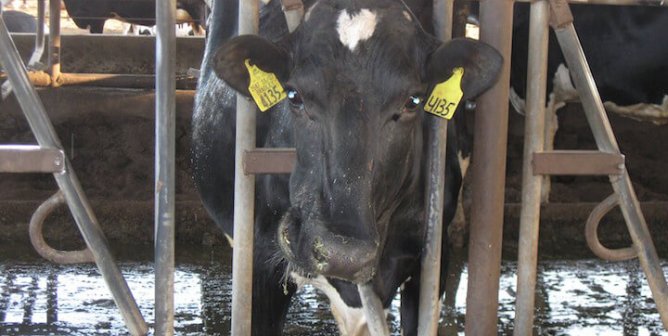The second reason for adopting a vegetarian diet is the environment. This one can be explained intuitively also. For example, a 200-pound man will burn off at least 2,000 calories a day even if he never gets out of bed. He uses most of what he consumes simply to power his body. Similarly, most of what we feed to chickens, pigs, and other farmed animals—most of it is burned off, simply keeping the animals alive until they’re slaughtered.
It’s bizarre, really: You take a crop like soybeans, oats, corn, or wheat, which are all high in protein, fiber, and complex carbohydrates but devoid of cholesterol and artery-clogging saturated fat. You feed them to an animal and create a product with no fiber or complex carbohydrates at all but with lots of cholesterol and saturated fat. It makes about as much sense as taking pure water, running it through a sewer system, and then drinking it.
In November 2006, the United Nations released a massive report that details the environmental consequences of eating meat. It’s called Livestock’s Long Shadow, and it concludes that raising chickens, pigs, and other animals for food is “one of the top two or three most significant contributors to the most serious environmental problems, at every scale from local to global.” Yes, no matter what environmental issue you’re looking at—from resource use to water pollution to air pollution to global warming—funneling crops through animals in order to eat meat is one of the top three causes.
E, the respected environmental magazine, noted that more than one-third of all fossil fuels produced in the United States are used to raise animals for food. It takes up to 13 pounds of grain to produce 1 pound of animal flesh. If we have to grow massive amounts of grain and soy—with all the tilling, irrigation, crop dusters, and so on that are required—truck all that grain and soybeans to factory-style farms and feedlots, feed it to the approximately 10 billion land animals who are raised for food in the U.S. each year, truck those animals to automated slaughter facilities, truck the dead animals to processing centers, run the processing and packaging machines, and then truck the packaged meat to grocery stores—well, there’s a lot of energy being used up at each one of those stages.
If all this energy is being used, all these fossil fuels are being burned, and all this manure is being produced, of course, we’re talking about serious air pollution. Many environmentalists would sooner walk or ride their bikes than drive in order to decrease air pollution in their area but then will happily eat meat, eggs, or dairy products without a second thought about the fact that they are paying for gas-guzzling animal-transport trucks, refrigerated meat trucks, pollution-churning processing plants, and so on.
My wife says that where the environment is concerned, eating meat is like driving a huge SUV or an 18-wheeler. Eating a vegetarian diet is like driving a motorcycle, and eating a vegan diet is like riding a bicycle or walking.
A similar analogy holds for land. According to John Robbins, the average vegan uses about one-sixth of an acre of land to satisfy his or her food requirements for a year; the average vegetarian who consumes dairy products and eggs requires about three times as much, and the average meat-eater requires about 20 times that much land. We can grow a lot more food on a given parcel of land if we’re not funneling crops through animals.
And think about water. According to the National Audubon Society, raising animals for food requires about as much water as all other water uses combined, even as many areas are experiencing drought conditions. It requires about 300 gallons of water to feed a vegan for a day. It requires about four times as much water to feed a vegetarian and 14 times as much to feed a meat-eater. Of course, if you have to feed animals, you have to irrigate the crops that you’re feeding them. You have to give them water. Factory farms and slaughterhouses have to be hosed down with water. It’s a water-intensive operation.
Raising animals for food is also a water-polluting process. One dairy cow produces more than 100 pounds of excrement per day. According to a U.S. Senate report, animals raised for food in the U.S. produce 130 times the excrement of the entire human population of this country. Their excrement is more concentrated than human excrement and is often contaminated with herbicides, pesticides, toxic chemicals, hormones, antibiotics, and so on. These massive farmed-animal factories generally don’t have waste-treatment plants. Instead, the manure is poured onto land or into giant lagoons, where it often spills over into local waterways, kills fish, and poisons the drinking water. Streams and rivers all over the middle of our country that once were clear and full of fish are now filthy and lifeless because of manure runoff from factory farms. There’s an enormous “dead zone” in the Gulf of Mexico now, where no fish or other animals live. This is largely because of the enormous amount of animal waste that has flowed from factory farms down rivers and streams and into the gulf.
Two of the most pressing environmental issues of the day are global warming and the destruction of the rain forest. In 2006, the University of Chicago published a major report stating that adopting a vegan diet is more important in the fight against global warming than switching to a hybrid car. That makes sense when you consider how many more resources are required to grow all those crops for chickens, pigs, and other animals.
As for the rain forest, most people know that the rain forest is being destroyed to create grazing space for cattle. But Greenpeace published a report in 2006 indicating that the new trend is for huge companies to clear rain-forest land to raise crops to feed to farmed animals. It specifically blamed the chicken industry for leading the way in the destruction of the Amazon, and it unveiled a banner in the Amazon that read, “KFC: Amazon Criminal,” because that company’s chickens were fed soy that had been grown in the rain forest.
Of course, anyone who reads the papers knows what factory-fishing trawlers are doing to our sea beds and ocean floors. One super-trawler is the length of a football field and takes in 800,000 pounds of fish in a single netting. Trawlers scrape along the ocean floor, destroying coral reefs and everything else in their way, and hydraulic dredges scoop up huge chunks of the ocean floor to sift out scallops, clams, and oysters. Most of what the fishing fleets get isn’t even eaten by human beings. Half is fed to animals who are raised for food, and about 30 million tons each year are just tossed back into the ocean, dead, which greatly disturbs the natural biological balance. Commercial fishing fleets are destroying sensitive aquatic ecosystems at a rate that is beyond comprehension. A major study found that in just the last 50 years, commercial fishing has reduced the populations of all large fish species by a staggering 90 percent.
Then there is aquaculture, which is increasing at a rate of more than 10 percent annually. Aquaculture is even worse than commercial fishing, because, for starters, it takes up to 5 pounds of wild-caught fish to reap 1 pound of farmed fish. Farmed fish eat fish caught by commercial trawlers that aren’t used for human consumption. Farmed fish are often raised in the same water that wild fish swim in, but fish farmers dump antibiotics into the water and use genetic breeding to create unnaturally large fish. The antibiotics contaminate the oceans and seas, and the genetically altered fish sometimes escape and breed with wild fish, throwing delicate aquatic balances out of kilter. Researchers at the University of Stockholm demonstrated that the horrible environmental influence of fish farms can extend to an area 50,000 times larger than the farm itself.
The choice is clear: We can demonstrate our environmental values every time we sit down to eat by eating a vegan meal, or we can trample over the Earth in a Hummer by eating meat, dairy products, and eggs. Really, a true environmentalist doesn’t eat animal products.





